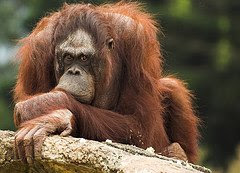
I recently did a short observational study of a captive Gorilla Gorilla carer and infant dyad and found some evidence for matching. This is only preliminary data and is part of my honours thesis. To my surprise often the infant (male, 8 months old) showed most matching during carer feeding time. The infant would watch the carer eating and would pick up a branch and try and imitate chewing (the infant is not weaned and will only be so at 2.5 years, it is still suckling). This was observed on several occasions. Indeed, only one bout of imitation from a juvenile playing was observed, the juvenile threw himself backwards and the infant immediately did the same! Despite as mentioned this being preliminary data and the many limitations (eg crowd management, distraction, and captivity to name a few) it is promising for further studies. Furthermore, due to the paucity of observational studies on imitation in primates this may provide some evidence for future directions. I will be conducting another short observational study in a captive Siamang carer dyad in May 2009 (infant is approximately 4 months old). Watch this space!









